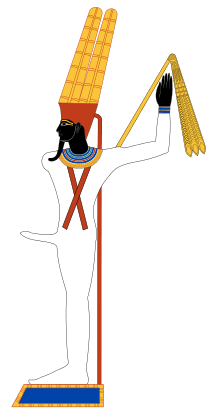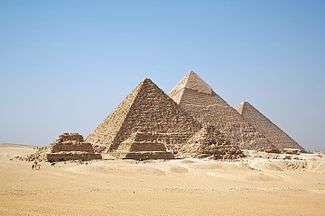Min (god)
| Min | ||||
|---|---|---|---|---|
 The dark-skinned fertility god Min, with an erect penis and a flail | ||||
| Name in hieroglyphs |
| |||
| Major cult center | Qift, Akhmim | |||
| Symbol | the lettuce, the phallus, the bull | |||
| Consort |
Iabet Isis | |||
| Parents | Isis | |||
Min (Egyptian mnw[1]) is an ancient Egyptian god whose cult originated in the predynastic period (4th millennium BCE).[2] He was represented in many different forms, but was most often represented in male human form, shown with an erect penis which he holds in his left hand and an upheld right arm holding a flail. As Khem or Min, he was the god of reproduction; as Khnum, he was the creator of all things, "the maker of gods and men".[3]
Myths and function
Min's cult began and was centered around Coptos (Koptos) and Akhmim (Panopolis) of upper Egypt,[4] where in his honour great festivals were held celebrating his “coming forth” with a public procession and presentation of offerings.[2] His other associations include the eastern desert and links to the god Horus. Flinders Petrie excavated two large statues of Min at Qift which are now in the Ashmolean Museum and it is thought by some that they are pre-dynastic. Although not mentioned by name a reference to 'he whose arm is raised in the East' in the Pyramid Texts is thought to refer to Min.[5]
%2C_the_God's_Father_of_Min._Ptolemaic%2C_27th_Dynasty._From_Egypt._The_Petrie_Museum_of_Egyptian_Archaeology%2C_London.jpg)
His importance grew in the Middle Kingdom when he became even more closely linked with Horus as the deity Min-Horus. By the New Kingdom he was also fused with Amun in the form of Min-Amun, who was also the serpent Irta, a kamutef (the "bull of his mother" - aka father of his own mother as well as her son). Min as an independent deity was also a kamutef of Isis. One of Isis's many places of cult throughout the valley was at Min's temple in Koptos as his divine wife.[6] Min's shrine was crowned with a pair of bull horns.[5]
As the central deity of fertility and possibly orgiastic rites Min became identified by the Greeks with the god Pan. One feature of Min worship was the wild prickly lettuce Lactuca virosa and Lactuca serriola of which is the domestic version Lactuca sativa (lettuce) which has aphrodisiac and opiate qualities and produce latex when cut, possibly identified with semen. He also had connections with Nubia. However, his main centers of worship remained at Coptos and Akhmim (Khemmis).[7]

Male deities as vehicles for fertility and potency rose to prevalence at the emergence of widespread agriculture. Male Egyptians would work in agriculture, making bountiful harvests a male-centered occasion. Thus, male gods of virility such as Osiris and Min were more developed during this time. Fertility was not associated with solely women, but with men as well, even increasing the role of the male in childbirth.[8] As a god of male sexual potency, he was honoured during the coronation rites of the New Kingdom, when the Pharaoh was expected to sow his seed — generally thought to have been plant seeds, although there have been controversial suggestions that the Pharaoh was expected to demonstrate that he could ejaculate — and thus ensure the annual flooding of the Nile. At the beginning of the harvest season, his image was taken out of the temple and brought to the fields in the festival of the departure of Min, the Min Festival, when they blessed the harvest, and played games naked in his honour, the most important of these being the climbing of a huge (tent) pole. This four day festival is evident from the great festivals list at the temple of Ramses III at Medinet Habu.[6][9]
Cult and worship in the predynastic period surrounding a fertility god was based upon the fetish of fossilized belemnite.[8] Later symbols widely used were the white bull, a barbed arrow, and a bed of lettuce, that the Egyptians believed to be an aphrodisiac. Egyptian lettuce was tall, straight, and released a milk-like sap when rubbed, characteristics superficially similar to the penis. Lettuce was sacrificially offered to the god, then eaten by men in an effort to achieve potency.[8] Later pharaohs would offer the first fruits of harvest to the god to ensure plentiful harvest, with records of offerings of the first stems of sprouts of wheat being offered during the Ptolemaic period.[8]
Even some war goddesses were depicted with the body of Min (including the phallus), and this also led to depictions, ostensibly of Min, with the head of a lioness.
In the 19th century, there was an alleged erroneous transcription of the Egyptian for Min as ḫm ("khem"). Since Khem was worshipped most significantly in Akhmim, the separate identity of Khem was reinforced, Akhmim being understood as simply a corruption of Khem. However, Akhmim is an alleged corruption of ḫm-mnw, meaning Shrine of Min, via the demotic form šmn.
Civilians who were not able to formally practice the cult of Min paid homage to the god as sterility was an unfavorable condition looked upon with sorrow. Concubine figurines, ithyphallic statuettes, and ex-voto phalluses were placed at entrances to the houses of Deir el-Medina to honor the god in hopes of curing the disability.[8] Egyptian women would touch the penises of statues of Min in hopes of pregnancy, a practice still continued today.[8]
Appearance
In Egyptian art, Min was depicted as an anthropomorphic male deity with a masculine body, covered in shrouds, wearing a crown with feathers, and often holding his penis erect in his left hand and a flail (referring to his authority, or rather that of the Pharaohs) in his upward facing right hand. Around his forehead, Min wears a red ribbon that trails to the ground, claimed by some to represent sexual energy. The legs are bandaged because of his chthonic force, in the same manner as Ptah and Osiris.[6] The large phallus is circumcised.[8]
Family
In Hymn to Min it is said:
See also
References
- ↑ Allen, James (2014). Middle Egyptian: An Introduction to the Language and Culture of Hieroglyphs (3rd ed.). Cambridge: Cambridge University Press. p. 493. ISBN 978-1-107-66328-2.
- 1 2 "Min". Encyclopædia Britannica. Encyclopædia Britannica Online. 2008. Retrieved 2008-03-27.
- ↑ Bechtel, F. (1907). "Ammon". The Catholic Encyclopedia. I. New York: Robert Appleton Company. Retrieved 2008-03-27.
- ↑ Alan., Lothian, (2012). Ancient Egypt's myths and beliefs. Rosen Pub. ISBN 978-1-4488-5994-8. OCLC 748941784.
- 1 2 Frankfort, Henry (1978). Kingship and the Gods: A Study of Ancient Near Eastern Religion as the Integration of Society and Nature. University of Chicago Press. pp. 187–189. ISBN 978-0-226-26011-2.
- 1 2 3 Christiane, Zivie-Coche, (2004). Gods and men in Egypt : 3000 BCE to 395 CE. Ithica: Cornell Univ. Press. pp. 17–18. ISBN 978-0-8014-4165-3. OCLC 845667204.
- ↑ Manchip., White, J. E. (2013). Ancient Egypt : Its Culture and History. Dover Publications. ISBN 978-0-486-22548-7. OCLC 868271431.
- 1 2 3 4 5 6 7 R., Najovits, Simson (2004). Egypt, trunk of the tree : a modern survey of an ancient land. Algora Pub. pp. 68, 93. ISBN 978-0-87586-222-4. OCLC 51647593.
- ↑ "Festivals in the ancient Egyptian calendar". www.ucl.ac.uk. Retrieved 2017-05-15.
Further reading
- McFarlane, A. (1995). The God Min to the End of the Old Kingdom. Australian Center for Egyptology. ISBN 9780856686788
External links

- Site on Min, with some pictures
- Min Illustrated description of Min
